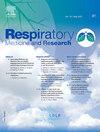成人胸膜感染的微生物学特征:来自三级呼吸保健医院的10年回顾性研究
IF 1.8
4区 医学
Q3 RESPIRATORY SYSTEM
引用次数: 0
摘要
胸膜感染是近二十年来发病率不断上升的高死亡率疾病。了解主要致病生物是进行适当治疗的重要一步。本研究旨在描述成人非结核性胸膜感染的病因学和抗生素耐药性特征,在三级护理中心专门治疗呼吸系统疾病。方法回顾性研究于2014年1月至2023年12月在突尼斯Ariana Abderrahmen Mami肺炎和生理学医院微生物实验室进行。收集来自不同临床服务的任何原因的胸腔积液的成年患者的胸膜液样本。采用常规技术进行细菌分离鉴定。药敏试验采用纸片扩散法和Vitek 2法。结果在研究期间共抽取5235份胸膜液标本。性别比M/F为2:1,年龄中位数为57岁(四分位数间距为43-68岁)。9.6% %的病例培养阳性,31.4% %的脓性胸膜液培养阳性。革兰氏染色检测微生物的灵敏度为41.5 %(95 % CI 35.6 ~ 47.6),特异性为99.8 %(95 % CI 99.6 ~ 99.9)。胸膜液白细胞计数1万/mL的敏感性为51.4 %(95 % CI 47.7-55.8),特异性为91.7 %(95 % CI 90.8-92.4)。共分离出微生物544株。主要病原菌为绿杆菌链球菌群(32.1% %)、肠杆菌科(25.3% %)、金黄色葡萄球菌(10. %)和厌氧菌(9.3% %)。肠杆菌科病原菌对第三代头孢菌素耐药率为19% %,对碳青霉烯类耐药率为6.4 %。青绿链球菌组中有19. %对青霉素G耐药。耐甲氧西林金黄色葡萄球菌百分比为14.2% %。结论化脓性胸膜液常规培养阳性率为31.4% %,革兰氏阳性菌是近10年来成人非结核性胸膜感染的主要原因。这些结果强调需要新的分子方法来提高培养阴性脓胸的诊断。本文章由计算机程序翻译,如有差异,请以英文原文为准。
Microbiological characteristics of pleural infection in adults: A 10-year retrospective study from a tertiary respiratory care hospital
Introduction
Pleural infection is a high-mortality disease with a rising incidence in the past two decades. The knowledge of the main causative organisms is an important step for appropriate treatment. This study aims to describe etiologic and antibiotic resistance features of non-tuberculous pleural infections in adults in a tertiary care center specializing in the treatment of respiratory diseases.
Methods
This retrospective study was conducted at the microbiology laboratory of Abderrahmen Mami pneumology and phthisiology hospital, Ariana, Tunisia from January 2014 to December 2023. Pleural fluid samples were collected from adult patients with pleural effusion, from any cause, admitted to the different clinical services. Bacterial isolation and identification were performed by conventional techniques. The disk diffusion and the Vitek 2 methods were used for the susceptibility testing.
Results
During the study period, 5235 pleural fluid specimens were included. The sex ratio M/F was 2:1, and the median age was 57 years (interquartile range: 43–68 years). Culture was positive in 9.6 % of all cases, and in 31.4 % of purulent pleural fluids. The Gram stain had 41.5 % (95 % CI 35.6–47.6) sensitivity and 99.8 % (95 % CI 99.6–99.9) specificity in detecting microorganisms. A pleural fluid leukocyte count >10,000/mL showed a sensitivity of 51.4 % (95 % CI 47.7–55.8) and a specificity of 91.7 % (95 % CI 90.8–92.4). A total of 544 microorganisms were isolated. The main causative microorganisms were viridans streptococci group (32.1 %), Enterobacteriaceae (25.3 %), Staphylococcus aureus (10.2 %), and anaerobes (9.3 %). Among Enterobacteriaceae, 19 % were resistant to third-generation cephalosporins and 6.4 % to carbapenems. The resistance to penicillin G was detected in 19 % of the viridans streptococci group. Methicilline Resistant Staphylococcus aureus percentage was 14.2 %.
Conclusion
Conventional culture yielded 31.4 % positivity in purulent pleural fluids, and Gram-positive organisms were the leading cause of non-tuberculous pleural infections in adults over the past ten years. These results highlight the need for new molecular methods to improve culture-negative empyema diagnosis.
求助全文
通过发布文献求助,成功后即可免费获取论文全文。
去求助
来源期刊

Respiratory Medicine and Research
RESPIRATORY SYSTEM-
CiteScore
2.70
自引率
0.00%
发文量
82
审稿时长
50 days
 求助内容:
求助内容: 应助结果提醒方式:
应助结果提醒方式:


